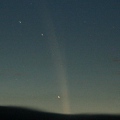
|
New Kreutz sungrazer comet discovered on the ground after 41-year blank since Comet C/1970 K1 (White-Ortiz-Bolelli). It approached nearly to the surface of the Sun on Dec. 16. It brightened much more rapidly than expected, and reached -4 mag or brighter at best. It looked amazing in the SOHO spacecraft images. The comet survived the perihelion passage, and it is showing the long tail again. It is appearing in the morning sky again in the Southern Hemisphere. It was observed on the ground as bright as -2.9 mag on Dec. 17 (Alexandre Amorim). It is bright as 1.1 mag still on Dec. 20 (Marco Goiato). In the morning sky, a bright long tail is visible from the horizon towards the sky. It will be observable in night sky in late December. Then it will be getting higher rapidly but fading rapidly. It is not observable in the Northern Hemisphere.
Date(TT) R.A. (2000) Decl. Delta r Elong. m1 Best Time(A, h)
Dec. 17 17 17.39 -25 10.1 0.915 0.103 4 -4.0 5:30 (290,-15)
Dec. 24 16 59.06 -40 0.1 0.682 0.434 21 4.7 5:34 (309,-14)
|
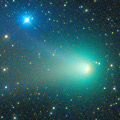
|
Now it is 6.7 mag (Dec. 7, Juan Jose Gonzalez). It keeps so bright as 6-8 mag for a long time from 2011 to 2012. In the Northern Hemisphere, it will be extremely low from late November to late December. But after that, it will be observable in excellent condition again. In the Southern Hemisphere, it is not observable now. But it will be observable again in 2012 spring, although it locates low.
Date(TT) R.A. (2000) Decl. Delta r Elong. m1 Best Time(A, h)
Dec. 17 17 30.36 23 8.9 2.057 1.553 46 6.2 5:30 (248, 9)
Dec. 24 17 30.38 24 40.7 2.008 1.551 48 6.1 5:34 (251, 16)
|

|
Now it is 9.7 mag (Dec. 7, Juan Jose Gonzalez). It will start fading after December. But it keeps observable in excellent condition for a while in the Northern Hemisphere. In the Southern Hemisphere, it keeps observable until 2012 spring when it fades down to 15-16 mag.
Date(TT) R.A. (2000) Decl. Delta r Elong. m1 Best Time(A, h)
Dec. 17 3 29.79 12 2.1 1.455 2.348 147 11.9 21:46 ( 0, 67)
Dec. 24 3 16.49 7 54.2 1.583 2.392 136 12.4 21:05 ( 0, 63)
|
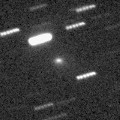
|
Now it is 12.2 mag and visible visually (Nov. 25, Seiichi Yoshida). It will reach up to 10 mag from January to March, but it will be too low to observe. It is already unobservable in the Southern Hemisphere. It is getting lower in the evening sky also in the Northern Hemisphere. It will be lower than 10 degree in early January.
Date(TT) R.A. (2000) Decl. Delta r Elong. m1 Best Time(A, h)
Dec. 17 19 16.32 -4 6.9 2.036 1.295 30 12.3 18:20 ( 76, 13)
Dec. 24 19 40.99 -4 26.2 1.998 1.241 29 11.9 18:24 ( 76, 11)
|

|
Now it is very bright as 10.6 mag (Nov. 28, Marco Goiato). It will be observable in good condition at 11-12 mag in autumn and winter.
Date(TT) R.A. (2000) Decl. Delta r Elong. m1 Best Time(A, h)
Dec. 17 0 12.65 1 8.3 1.620 2.021 98 12.0 18:31 ( 0, 56)
Dec. 24 0 22.50 1 48.1 1.688 2.015 94 12.0 18:24 ( 5, 57)
|

|
It was observed as bright as 13.9 mag in 2011 autumn (Oct. 19, Hidetaka Sato). It is not observable now. In the Northern Hemisphere, it will be observable again in 2012 summer, when it will be fainter than 15 mag. In the Southern Hemisphere, it will never be observable again.
Date(TT) R.A. (2000) Decl. Delta r Elong. m1 Best Time(A, h)
Dec. 17 18 46.66 -20 51.7 2.355 1.439 16 12.1 18:20 ( 67, -3)
Dec. 24 19 8.62 -18 21.3 2.332 1.406 15 12.0 18:24 ( 70, -3)
|

|
It is not observable at all due to the bad condition in this apparition.
Date(TT) R.A. (2000) Decl. Delta r Elong. m1 Best Time(A, h)
Dec. 17 16 46.70 -17 21.3 2.087 1.150 13 12.4 5:30 (288, -5)
Dec. 24 17 14.62 -18 6.1 2.125 1.190 13 12.9 5:34 (289, -5)
|

|
It brightened up to 17.1 mag in late June (June 24, J. F. Hernandez). The condition of this apparition is bad, and it is not observable around the perihelion passage. It will appear in the morning sky at 14 mag in 2012 April in the Southern Hemisphere. It will not be observable until 2012 June in the Northern Hemisphere, when the comet will be 15.5 mag.
Date(TT) R.A. (2000) Decl. Delta r Elong. m1 Best Time(A, h)
Dec. 17 17 47.16 -26 15.9 2.548 1.568 3 13.3 18:20 ( 70,-17)
Dec. 24 18 11.14 -26 38.8 2.550 1.569 3 13.2 18:24 ( 70,-19)
|

|
Now it is bright as 13.3 mag (Dec. 6, Hidetaka Sato). It keeps bright as 13-14 mag for a long time after this until 2013. It is not observable in the Northern Hemisphere, but it is observable in good condition in the Southern Hemisphere.
Date(TT) R.A. (2000) Decl. Delta r Elong. m1 Best Time(A, h)
Dec. 17 19 52.18 -88 31.5 5.791 5.456 65 13.5 18:20 ( 2,-34)
Dec. 24 22 47.00 -87 31.7 5.785 5.455 65 13.5 18:24 ( 1,-33)
|

|
It brightened up to 14.1 mag in August and September (Aug. 11, Artyom Novichonok and Vladimir Gerke). Now it is not observable. It will appear in the morning sky at 14 mag at the end of February. Then it will be observable in good condition in the Southern Hemisphere while fading gradually. It will locate somewhat low in the Northern Hemisphere. In 2011, some visual observers reported it was very bright as 10-12 mag.
Date(TT) R.A. (2000) Decl. Delta r Elong. m1 Best Time(A, h)
Dec. 17 17 51.51 -12 12.9 3.300 2.345 11 13.6 18:20 ( 81, -9)
Dec. 24 18 7.57 -12 55.2 3.307 2.347 10 13.7 5:34 (277,-12)
|
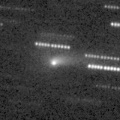
|
Now it is bright as 12.8 mag and visible visually (Dec. 3, Marco Goiato). t keeps the current brightness until December. Then it starts fading, but it keeps observable in good condition until May when it becomes fainter than 18 mag. It locates somewhat low in the Southern Hemisphere. Juan Jose Gonzalez reported it so bright as 10.2 mag visually on Nov. 24.
Date(TT) R.A. (2000) Decl. Delta r Elong. m1 Best Time(A, h)
Dec. 17 11 34.40 9 10.2 1.150 1.565 94 13.8 5:30 (347, 64)
Dec. 24 11 47.94 10 3.0 1.124 1.597 98 14.0 5:34 (357, 65)
|
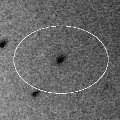
|
Appearing in the morning sky. Now it is bright as 14.1 mag but very diffuse (Nov. 26, Toshiyuki Takahashi). Juan Jose Gonzalez reported a very faint large coma, remnant of an old outburst, is visible with a total brightness of 10.0 mag on Nov. 24.
Date(TT) R.A. (2000) Decl. Delta r Elong. m1 Best Time(A, h)
Dec. 17 12 33.59 -11 17.8 6.487 6.262 72 14.0 5:30 (333, 40)
Dec. 24 12 35.87 -11 43.1 6.377 6.262 78 14.0 5:34 (342, 42)
|

|
Big asteroid discovered in 1906. It suddenly showed the cometary activity on Dec. 11, 2010, probably due to an impact of a small object. It was very bright as 11.5 mag visually (Dec. 17, 2010, Juan Jose Gonzalez). It had a dust coma still on Jan. 9, 2011 (Joseph Brimacombe). Then it turned to be stellar at 13.8 mag (Apr. 5, Juan Jose Gonzalez). Appearing in the morning sky in the Northern Hemisphere.
Date(TT) R.A. (2000) Decl. Delta r Elong. m1 Best Time(A, h)
Dec. 17 14 46.06 -7 12.4 3.153 2.536 43 14.3 5:30 (299, 24)
Dec. 24 14 57.50 -8 11.0 3.081 2.528 47 14.3 5:34 (303, 27)
|
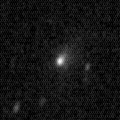
|
It brightened up to 12.3 mag around the perihelion passage, although it located very low (Oct. 19, Hidetaka Sato). Now it is 13.7 mag (Dec. 6, Hidetaka Sato). The condition of this apparition is bad. In the Northern Hemisphere, it is only observable from December to February in the evening very low sky. In the Southern Hemisphere, it keeps observable for a long time, although it keeps locating extremely low. The component B was not detected, fainter than 20 mag, on May 14 (Hidetaka Sato).
Date(TT) R.A. (2000) Decl. Delta r Elong. m1 Best Time(A, h)
Dec. 17 20 42.63 -26 25.9 1.822 1.277 42 14.3 18:20 ( 44, 13)
Dec. 24 21 11.98 -24 33.2 1.897 1.339 42 14.7 18:24 ( 46, 14)
|

|
Now it is 14.3 mag and visible visually (Oct. 1, Jakub Cerny). It will be observable at 13-14 mag for a long time from 2011 to 2012. However, it will be unobservable temporarily from November to January.
Date(TT) R.A. (2000) Decl. Delta r Elong. m1 Best Time(A, h)
Dec. 17 18 2.66 -13 54.8 6.175 5.213 11 14.3 18:20 ( 79, -8)
Dec. 24 18 4.53 -14 1.4 6.172 5.204 9 14.3 5:34 (278,-13)
|

|
It was expected to keep 14-15 mag for a long time from 2011 summer to 2012 summer. However, it is lost. It was observed only during two days in 2010 June. So the orbital elements are extremely uncertain. The condition is good in the Southern Hemisphere. But in the Northern Hemisphere, it is not observable until 2012 August.
Date(TT) R.A. (2000) Decl. Delta r Elong. m1 Best Time(A, h)
Dec. 17 18 42.52 -68 52.6 2.940 2.375 46 14.6 18:20 ( 24,-29)
Dec. 24 19 19.29 -69 55.8 2.903 2.357 47 14.5 18:24 ( 22,-29)
|

|
Now it is visible visually at 13.6 mag (Nov. 27, Jakub Cerny). It is expected to be 13 mag and will be observable in good condition in 2013. In the Northern Hemisphere, it keeps observable for a long time after this. It is not observable in the Southern Hemisphere.
Date(TT) R.A. (2000) Decl. Delta r Elong. m1 Best Time(A, h)
Dec. 17 22 57.17 55 27.5 6.628 6.929 103 14.7 18:20 (156, 67)
Dec. 24 22 55.70 54 21.3 6.679 6.904 99 14.7 18:24 (146, 64)
|
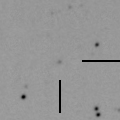
|
It brightened up to 16.6 mag on Oct. 12 (Hidetaka Sato). But it is not observable now. It will keep unobservable until it becomes fainter than 18 mag.
Date(TT) R.A. (2000) Decl. Delta r Elong. m1 Best Time(A, h)
Dec. 17 18 40.99 -25 39.1 2.507 1.576 14 14.9 18:20 ( 64, -7)
Dec. 24 19 4.51 -24 46.4 2.523 1.581 13 15.0 18:24 ( 65, -8)
|

|
It is expected to be bright as 9 mag from 2012 to 2013. Now it is 14.9 mag (Dec. 1, P. Dupouy). In the Northern Hemisphere, it keeps observable in good condition for a long time until 2012 autumn when the comet brightens up to 10 mag. In the Southern Hemisphere, it is hardly observble before the perihelion passage. But it becomes observable in good condition since 2013 after the perihelion passage.
Date(TT) R.A. (2000) Decl. Delta r Elong. m1 Best Time(A, h)
Dec. 17 14 39.00 43 41.8 4.801 4.702 78 15.1 5:30 (241, 50)
Dec. 24 14 47.19 43 53.2 4.685 4.641 81 15.0 5:34 (242, 54)
|

|
Now it is 15.3 mag (Nov. 20, K. Hills). It is expected to be observable at 13 mag for a long time from 2012 summer to 2013 summer. It will be observable in excellent condition in the Southern Hemisphere. But it is not observable at brightest time in the Northern Hemisphere. It keeps observable for a while at 16 mag while brightening gradually.
Date(TT) R.A. (2000) Decl. Delta r Elong. m1 Best Time(A, h)
Dec. 17 1 19.47 -34 22.4 3.755 3.982 96 15.4 19:36 ( 0, 21)
Dec. 24 1 14.21 -34 25.3 3.804 3.923 89 15.3 19:04 ( 0, 21)
|

|
New comet discovered in the spacecraft images. It was observed so bright as 9.4 mag (Sept. 22, Chris Wyatt). Appearing in the morning sky in the Northern Hemisphere. It is still bright as 13.2 mag and visible visually (Nov. 24, Seiichi Yoshida). It will be observable while fading gradually after this. In the Southern Hemisphere, further observations are very hard.
Date(TT) R.A. (2000) Decl. Delta r Elong. m1 Best Time(A, h)
Dec. 17 14 30.51 12 41.8 2.044 1.735 57 15.3 5:30 (284, 40)
Dec. 24 14 28.88 15 47.2 1.970 1.812 66 15.6 5:34 (287, 48)
|
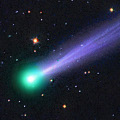
|
It passed very near by the earth, within 0.1 A.U., and brightened up to 8.0 mag in the southern sky (Aug. 14, Willian Souza). After appearing in the morning sky in late September, it brightened up to 6.6 mag (Sept. 25, Juan Jose Gonzalez). Now it is fading, but still visible visually at 13.5 mag (Nov. 25, Seiichi Yoshida).
Date(TT) R.A. (2000) Decl. Delta r Elong. m1 Best Time(A, h)
Dec. 17 13 38.73 -6 22.2 1.732 1.494 59 15.8 5:30 (312, 36)
Dec. 24 13 47.78 -6 59.8 1.742 1.584 64 16.2 5:34 (319, 39)
|

|
First return of a new periodic comet which brightened up to 13 mag in a major outburst in 2005. In this apparition, it brightened up to 12 mag in 2011 summer and autumn. Now it is fading. It has already faded down to 15.0 mag (Nov. 27, Jakub Cerny). It keeps observable in good condition until February when it fades out down to 17-18 mag. Its fragments have not been observed since early October.
Date(TT) R.A. (2000) Decl. Delta r Elong. m1 Best Time(A, h)
Dec. 17 23 20.60 6 40.8 2.293 2.481 89 16.1 18:20 ( 21, 60)
Dec. 24 23 29.26 7 22.2 2.403 2.505 84 16.4 18:24 ( 32, 59)
|

|
Now it is bright as 16.2 mag (Dec. 13, V. Gerke, S. Plaksa, A. Novichonok). Although it was extremely faint as 20.5 mag at the recovery in 2010 autumn, it brightened rapidly. It will keep 15 mag and observable in good condition for a long time from 2012 to 2013. But it locates somewhat low in the Northern Hemisphere in 2013.
Date(TT) R.A. (2000) Decl. Delta r Elong. m1 Best Time(A, h)
Dec. 17 13 3.73 9 47.5 3.672 3.536 74 16.4 5:30 (308, 54)
Dec. 24 13 10.00 9 33.0 3.558 3.518 79 16.4 5:34 (317, 58)
|
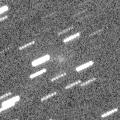
|
First return of a new comet which brightened up to 9.5 mag in a major outburst in 2006. It was recovered on Dec. 17, but much fainter than expected. Now it is 16.9 mag (Dec. 17, Vladimir Gerke and Artyom Novichonok). It will approach to the earth down to 0.24 A.U. in January, and will be observable in excellent condition. It may brighten up to around 15 mag.
Date(TT) R.A. (2000) Decl. Delta r Elong. m1 Best Time(A, h)
Dec. 17 23 5.78 27 0.5 0.390 1.085 94 17.0 18:20 ( 60, 76)
Dec. 24 23 28.44 24 12.1 0.354 1.053 91 16.4 18:24 ( 56, 72)
|
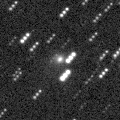
|
Although it has passed the perihelion in 2010 November, it is uxexpectedly bright as 16.0 mag still now (Nov. 20, P. Dupouy). It keeps observable in excellent condition until winter. It will keep 16-17 mag for a while after this.
Date(TT) R.A. (2000) Decl. Delta r Elong. m1 Best Time(A, h)
Dec. 17 6 28.01 5 4.0 3.877 4.803 157 16.5 0:49 ( 0, 60)
Dec. 24 6 19.79 5 57.1 3.906 4.852 162 16.5 0:13 ( 0, 61)
|

|
It became bright as 12 mag in 2010. Now it is fading. It has already faded down to 16.2 mag (Nov. 14, V. Gerke, A. Novichonok, S. Plaksa).
Date(TT) R.A. (2000) Decl. Delta r Elong. m1 Best Time(A, h)
Dec. 17 1 28.02 1 51.6 3.484 4.018 116 16.8 19:45 ( 0, 57)
Dec. 24 1 28.04 2 12.5 3.600 4.035 109 16.9 19:18 ( 0, 57)
|

|
Now it is 16.9 mag (Nov. 14, A. Tudorica, T. Badescu). It will be fading very slowly after this. In the Northern Hemisphere, it keeps observable for a long time until 2012 spring when it fades down to 17-18 mag. It will not be observable in the Southern Hemisphere.
Date(TT) R.A. (2000) Decl. Delta r Elong. m1 Best Time(A, h)
Dec. 17 22 47.65 35 41.6 5.561 5.719 94 16.8 18:20 ( 98, 75)
Dec. 24 22 52.58 34 50.5 5.681 5.752 89 16.9 18:24 ( 97, 69)
|

|
It keeps 17 mag for a long time from 2011 summer to 2012 spring. It keeps observable all thgough the period in good condition in the Southern Hemisphere. In the Northern Hemisphere, it is not observable until 2012 spring when it becomes fainter than 18 mag. No observations have been reported since August.
Date(TT) R.A. (2000) Decl. Delta r Elong. m1 Best Time(A, h)
Dec. 17 13 0.61 -71 49.3 2.301 2.023 61 16.9 5:30 (351,-19)
Dec. 24 12 37.88 -72 59.4 2.252 2.049 65 16.9 5:34 (356,-18)
|
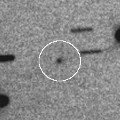
|
Now it is 16.8 mag (Nov. 15, V. Gerke. A. Novichonok, S. Plaksa, D. Chestnov). It tends to be brightest after the perihelion passage. In the Northern Hemisphere, it keeps observable at 17 mag in good condition from autumn to winter. In the Southern Hemisphere, it locates low and will be hard to observe.
Date(TT) R.A. (2000) Decl. Delta r Elong. m1 Best Time(A, h)
Dec. 17 11 13.46 21 20.9 2.029 2.449 103 16.9 5:30 (357, 76)
Dec. 24 11 17.58 22 3.0 1.984 2.490 109 16.9 5:10 ( 0, 77)
|

|
Now it is 15.7 mag (Dec. 7, Hidetaka Sato), brighter than this ephemeris. Sato reported a small outburst occured. In the Northern Hemisphere, it keeps locating the same altitude in the morning sky. In the Southern Hemisphere, it locates extremely low now, but it will be getting higher gradually. The ephemeris says it will be fainter than 18 mag in late January. But it may keep brighter some more time. Juan Jose Gonzalez reported that it was visible as a 11.3-mag diffuse comet visually on Oct. 9.
Date(TT) R.A. (2000) Decl. Delta r Elong. m1 Best Time(A, h)
Dec. 17 13 28.31 -23 22.7 1.642 1.370 56 16.9 5:30 (326, 23)
Dec. 24 13 45.50 -25 57.6 1.667 1.432 58 17.2 5:34 (330, 22)
|

|
Now it is 16.4 mag (Nov. 23, Catalina Sky Survey). It was observed at 17.5 mag in 2011 spring, when the condition was good in the Southern Hemisphere. It will be observable at 17 mag in this winter, when the condition is good in the Northern Hemisphere.
Date(TT) R.A. (2000) Decl. Delta r Elong. m1 Best Time(A, h)
Dec. 17 9 57.55 26 12.1 1.741 2.403 121 17.0 4:18 ( 0, 81)
Dec. 24 9 34.25 30 2.0 1.654 2.439 133 17.0 3:28 ( 0, 85)
|
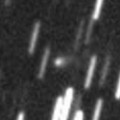
|
Now it is 16.7 mag (Dec. 5, Hidetaka Sato), brighter than the early ephemeris. It keeps observable in good condition for a while after this. It keeps 17 mag until February.
Date(TT) R.A. (2000) Decl. Delta r Elong. m1 Best Time(A, h)
Dec. 17 7 55.80 2 40.2 1.478 2.322 140 17.0 2:16 ( 0, 58)
Dec. 24 7 52.65 1 48.6 1.445 2.329 146 17.0 1:45 ( 0, 57)
|
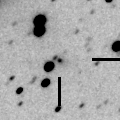
|
Now it is bright as 16.8 mag (Nov. 23, Catalina Sky Survey). Although it was extremely faint as 21 mag at the discovery in late October, it brightened rapidly. It will keep 17 mag until the end of January. It may fade out rapidly after that. It locates somewhat low in the Southern Hemisphere, but it is observable in good condition in the Northern Hemisphere.
Date(TT) R.A. (2000) Decl. Delta r Elong. m1 Best Time(A, h)
Dec. 17 4 23.07 33 29.0 1.098 2.054 161 17.0 22:40 ( 0, 89)
Dec. 24 4 20.09 33 54.6 1.126 2.058 154 17.1 22:09 ( 0, 89)
|
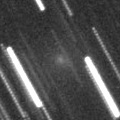
|
Extremely diffuse and hardly detected by CCD images. The nucleus is already fainter than 18 mag (Oct. 15, Jean-Francois Soulier). The comet can be already disintegrated. However, Juan Jose Gonzalez reported it so bright as 9.5 mag visually on Sept. 25. It is observable in good condition in the Southern Hemisphere. In the Northern Hemisphere, it keeps locating higher than 20 degree from November to December. No observations have been reported since October.
Date(TT) R.A. (2000) Decl. Delta r Elong. m1 Best Time(A, h)
Dec. 17 11 50.50 -32 22.6 1.890 1.890 74 17.1 5:30 (351, 22)
Dec. 24 11 46.11 -36 25.6 1.891 1.979 80 17.2 5:34 (359, 19)
|
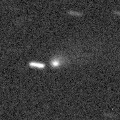
|
It was revealed to be a comet when appearing in the morning sky in early August. It was visible as 13.8 mag and visible visually (Sept. 4, Sandor Szabo). Now it is fading. It has already faded down to 16.8 mag (Nov. 20, A. Diepvens). In the Northern Hemisphere, it keeps observable in excellent condition for a long time until 2012 summer. But it will be fainter than 18 mag in late January. It is not observable at all in the Southern Hemisphere.
Date(TT) R.A. (2000) Decl. Delta r Elong. m1 Best Time(A, h)
Dec. 17 12 0.18 50 46.1 2.648 3.043 104 17.1 5:30 (206, 72)
Dec. 24 12 3.68 51 39.5 2.636 3.095 108 17.2 5:34 (192, 73)
|

|
It brightened up to 13-14 mag and became visible visually from 2007 to 2009. Now it is fading. But it is still bright as 17.5 mag (Oct. 28, Ken-ichi Kadota). In the Northern Hemisphere, it keeps observable in excellent condition until early summer in 2012. In the Southern Hemisphere, it locates extremely low only.
Date(TT) R.A. (2000) Decl. Delta r Elong. m1 Best Time(A, h)
Dec. 17 10 53.71 37 7.0 10.684 11.089 111 17.1 5:13 (180, 88)
Dec. 24 10 51.79 37 29.0 10.622 11.125 118 17.1 4:44 (180, 88)
|
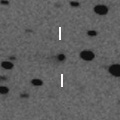
|
Now it is 17.5 mag (Nov. 15, A. Diepvens). It keeps observable at 17 mag for a long time from 2011 to 2012.
Date(TT) R.A. (2000) Decl. Delta r Elong. m1 Best Time(A, h)
Dec. 17 23 28.31 11 29.4 7.995 8.103 92 17.1 18:20 ( 21, 65)
Dec. 24 23 27.08 11 12.4 8.127 8.109 85 17.1 18:24 ( 37, 62)
|
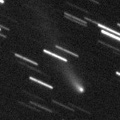
|
It reached up to 14 mag in 2010 autumn and winter. Now it is fading. It has already faded down to 16.6 mag (Sept. 14, Hidetaka Sato). In the Southern Hemisphere, it keeps observable in good condition while fading gradually. In the Northern Hemisphere, it will never be observable again.
Date(TT) R.A. (2000) Decl. Delta r Elong. m1 Best Time(A, h)
Dec. 17 1 11.42 -78 28.0 4.422 4.218 71 17.1 19:27 ( 0,-23)
Dec. 24 0 49.21 -77 8.3 4.507 4.263 69 17.2 18:38 ( 0,-22)
|
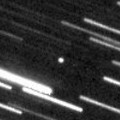
|
Now it is 17.5 mag (Nov. 5, LINEAR). It keeps observable in good condition at 17-18 mag until March. It locates low in the Southern Hemisphere.
Date(TT) R.A. (2000) Decl. Delta r Elong. m1 Best Time(A, h)
Dec. 17 2 15.12 30 28.9 1.213 2.031 134 17.3 20:31 ( 0, 85)
Dec. 24 2 3.05 28 7.0 1.247 1.986 125 17.4 19:52 ( 0, 83)
|
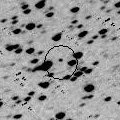
|
Peculiar asteroid moving along a cometary orbit. Now it is 18.4 mag (Oct. 26, Hidetaka Sato). It keeps observable at 18 mag for a long time from 2008 to 2014.
Date(TT) R.A. (2000) Decl. Delta r Elong. m1 Best Time(A, h)
Dec. 17 7 59.53 10 33.2 5.799 6.616 143 17.3 2:20 ( 0, 65)
Dec. 24 7 55.09 11 12.6 5.740 6.622 151 17.3 1:48 ( 0, 66)
|

|
Now it is 17.3 mag (Nov. 21, J. F. Soulier). It keeps observable at 18 mag for a long time until 2013.
Date(TT) R.A. (2000) Decl. Delta r Elong. m1 Best Time(A, h)
Dec. 17 5 20.44 26 8.9 2.939 3.920 175 17.3 23:37 ( 0, 81)
Dec. 24 5 15.72 26 3.5 2.952 3.920 168 17.3 23:05 ( 0, 81)
|

|
It reached up to 8.1 mag in mid August (Aug. 19, Michael Mattiazzo). However, the nucleus has been disintegrated, and it faded out and got diffuse very rapidly. The necleus has been already fainter than 22.5 mag and unable to be detected (Oct. 23, Jakub Cerny). But the remnant of the comet, extremely large, diffuse and elongated, was detected by CCD images in late October. Juan Jose Gonzalez reported the remnant is still visible visually on Nov. 24, and the total magnitude is 9.5 mag.
Date(TT) R.A. (2000) Decl. Delta r Elong. m1 Best Time(A, h)
Dec. 17 3 13.35 21 22.3 1.057 1.958 147 17.3 21:30 ( 0, 76)
Dec. 24 3 11.39 20 56.3 1.214 2.062 139 17.9 21:01 ( 0, 76)
|
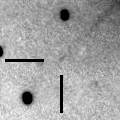
|
Now it is 17.5 mag (Nov. 14, K. Hills). It keeps 17-18 mag until early 2013. It keeps observable in good condition until early 2012 in the Southern Hemisphere, although it locates low in the Northern Hemisphere. In the Northern Hemisphere, it will be observable in good condition from 2012 autumn to early 2013.
Date(TT) R.A. (2000) Decl. Delta r Elong. m1 Best Time(A, h)
Dec. 17 0 30.17 -34 35.3 3.000 3.112 87 17.3 18:48 ( 0, 21)
Dec. 24 0 33.82 -32 37.9 3.057 3.093 82 17.3 18:24 ( 0, 23)
|
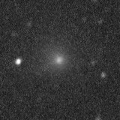
|
It has returned after 27-year blank since 1984. It brightened very rapidly, and became very bright as 9.1 mag (July 10, Tsutomu Seki). It may keep bright after the perihelion passage. It was visible in SWAN images still on Sept. 17 (Hirohisa Sato). Tsutomu Seki reported the comet is about 15 mag in early November, although he commented that confirmation is required.
Date(TT) R.A. (2000) Decl. Delta r Elong. m1 Best Time(A, h)
Dec. 17 14 15.08 -32 28.1 2.852 2.265 44 17.4 5:30 (322, 10)
Dec. 24 14 25.16 -33 23.1 2.870 2.349 49 17.7 5:34 (326, 12)
|
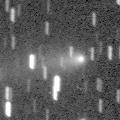
|
It had been fading after the perihelion passage in 2010 October, but it brightened again in outburst on Apr. 5, 2011. It reached up to 14.7 mag in May (May 28, Hidetaka Sato). It has been unobservable since July. But it is appearing in the morning sky now. Now it is 17.3 mag, much brighter than expected (Nov. 26, Hidetaka Sato). It locates low in the Southern Hemisphere. But in the Northern Hemisphere, it keeps observable in good condition after this. It will keep 17 mag for a while.
Date(TT) R.A. (2000) Decl. Delta r Elong. m1 Best Time(A, h)
Dec. 17 13 25.60 14 37.5 3.817 3.636 72 17.5 5:30 (296, 54)
Dec. 24 13 31.12 14 36.0 3.752 3.665 77 17.5 5:34 (303, 58)
|

|
Now it is 17.4 mag (Nov. 24, V. Gerke. A. Novichonok, S. Plaksa, D. Chestnov). It will be observable in good condition at 18 mag from autumn to winter.
Date(TT) R.A. (2000) Decl. Delta r Elong. m1 Best Time(A, h)
Dec. 17 2 58.21 -15 8.4 3.358 4.010 125 17.7 21:15 ( 0, 40)
Dec. 24 2 56.68 -14 57.6 3.428 4.007 119 17.7 20:46 ( 0, 40)
|

|
It is expected to keep 13 mag and observable in good condition in the Northern Hemisphere for a long time from 2013 to 2014. Now it is 18.3 mag (Nov. 7, Hidetaka Sato). It keeps observable at 17-18 mag in good condition until 2012 June.
Date(TT) R.A. (2000) Decl. Delta r Elong. m1 Best Time(A, h)
Dec. 17 11 34.67 -3 29.8 7.095 7.145 88 17.8 5:30 (350, 51)
Dec. 24 11 34.26 -3 13.8 6.924 7.099 96 17.7 5:26 ( 0, 52)
|
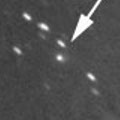
|
Now it is 17.2 mag (Nov. 14, V. Gerke, A. Novichonok, S. Plaksa). It will be observable in good condition for a while. But it will be fainter than 18 mag in December.
Date(TT) R.A. (2000) Decl. Delta r Elong. m1 Best Time(A, h)
Dec. 17 0 1.72 -5 20.1 1.732 2.047 93 17.9 18:20 ( 0, 50)
Dec. 24 0 11.93 -4 8.5 1.811 2.052 89 18.0 18:24 ( 8, 51)
|
|
![]()
 71P/Clark
71P/Clark C/2009 F4 ( McNaught )
C/2009 F4 ( McNaught ) C/2011 A3 ( Gibbs )
C/2011 A3 ( Gibbs ) 49P/Arend-Rigaux
49P/Arend-Rigaux 29P/Schwassmann-Wachmann 1
29P/Schwassmann-Wachmann 1 (596) Scheila
(596) Scheila 73P/Schwassmann-Wachmann 3
73P/Schwassmann-Wachmann 3 C/2006 S3 ( LONEOS )
C/2006 S3 ( LONEOS ) C/2010 M1 ( Gibbs )
C/2010 M1 ( Gibbs ) C/2010 S1 ( LINEAR )
C/2010 S1 ( LINEAR ) 37P/Forbes
37P/Forbes C/2011 F1 ( LINEAR )
C/2011 F1 ( LINEAR ) C/2011 R1 ( McNaught )
C/2011 R1 ( McNaught ) C/2011 Q4 ( SWAN )
C/2011 Q4 ( SWAN ) 45P/Honda-Mrkos-Pajdusakova
45P/Honda-Mrkos-Pajdusakova 213P/2009 B3 ( Van Ness )
213P/2009 B3 ( Van Ness ) 246P/2010 V2 ( NEAT )
246P/2010 V2 ( NEAT ) P/2006 T1 = P/2011 Y1 ( Levy )
P/2006 T1 = P/2011 Y1 ( Levy ) C/2010 FB87 ( WISE-Garradd )
C/2010 FB87 ( WISE-Garradd ) 65P/Gunn
65P/Gunn C/2008 FK75 ( Lemmon-Siding Spring )
C/2008 FK75 ( Lemmon-Siding Spring ) C/2011 L2 ( McNaught )
C/2011 L2 ( McNaught ) 164P/Christensen
164P/Christensen C/2011 S2 ( Kowalski )
C/2011 S2 ( Kowalski ) C/2011 G1 ( McNaught )
C/2011 G1 ( McNaught ) P/2011 W2 ( Rinner )
P/2011 W2 ( Rinner ) P/2011 UA134 ( Spacewatch-PanSTARRS )
P/2011 UA134 ( Spacewatch-PanSTARRS ) C/2011 M1 ( LINEAR )
C/2011 M1 ( LINEAR ) P/2010 JC81 ( WISE )
P/2010 JC81 ( WISE ) C/2005 L3 ( McNaught )
C/2005 L3 ( McNaught ) C/2008 S3 ( Boattini )
C/2008 S3 ( Boattini ) C/2010 B1 ( Cardinal )
C/2010 B1 ( Cardinal ) (3200) Phaethon
(3200) Phaethon 2008 YB3
2008 YB3 244P/2010 Q1 ( Scotti )
244P/2010 Q1 ( Scotti ) C/2010 X1 ( Elenin )
C/2010 X1 ( Elenin ) P/2011 N1 ( ASH )
P/2011 N1 ( ASH ) 27P/Crommelin
27P/Crommelin 240P/2010 P1 ( NEAT )
240P/2010 P1 ( NEAT ) 242P/2010 P3 ( Spahr )
242P/2010 P3 ( Spahr ) C/2011 J2 ( LINEAR )
C/2011 J2 ( LINEAR ) 253P/2011 R2 ( PanSTARRS )
253P/2011 R2 ( PanSTARRS )![]()













































